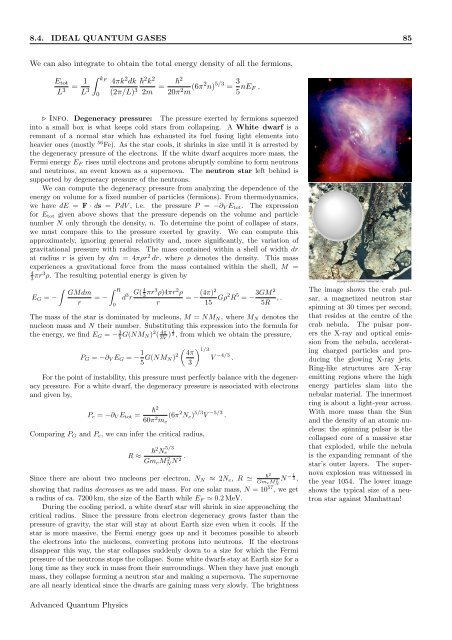Identical Particles - Theory of Condensed Matter
Identical Particles - Theory of Condensed Matter
Identical Particles - Theory of Condensed Matter
Create successful ePaper yourself
Turn your PDF publications into a flip-book with our unique Google optimized e-Paper software.
8.4. IDEAL QUANTUM GASES 85<br />
We can also integrate to obtain the total energy density <strong>of</strong> all the fermions,<br />
Etot 1<br />
=<br />
L3 L3 kF<br />
0<br />
4πk2dk (2π/L) 3<br />
2k2 2m<br />
= 2<br />
20π 2 m (6π2 n) 5/3 = 3<br />
5 nEF .<br />
⊲ Info. Degeneracy pressure: The pressure exerted by fermions squeezed<br />
into a small box is what keeps cold stars from collapsing. A White dwarf is a<br />
remnant <strong>of</strong> a normal star which has exhausted its fuel fusing light elements into<br />
heavier ones (mostly 56 Fe). As the star cools, it shrinks in size until it is arrested by<br />
the degeneracy pressure <strong>of</strong> the electrons. If the white dwarf acquires more mass, the<br />
Fermi energy EF rises until electrons and protons abruptly combine to form neutrons<br />
and neutrinos, an event known as a supernova. The neutron star left behind is<br />
supported by degeneracy pressure <strong>of</strong> the neutrons.<br />
We can compute the degeneracy pressure from analyzing the dependence <strong>of</strong> the<br />
energy on volume for a fixed number <strong>of</strong> particles (fermions). From thermodynamics,<br />
we have dE = F · ds = P dV , i.e. the pressure P = −∂V Etot. The expression<br />
for Etot given above shows that the pressure depends on the volume and particle<br />
number N only through the density, n. To determine the point <strong>of</strong> collapse <strong>of</strong> stars,<br />
we must compare this to the pressure exerted by gravity. We can compute this<br />
approximately, ignoring general relativity and, more significantly, the variation <strong>of</strong><br />
gravitational pressure with radius. The mass contained within a shell <strong>of</strong> width dr<br />
at radius r is given by dm = 4πρr 2 dr, where ρ denotes the density. This mass<br />
experiences a gravitational force from the mass contained within the shell, M =<br />
4<br />
3 πr3 ρ. The resulting potential energy is given by<br />
R<br />
GMdm<br />
EG = −<br />
= −<br />
r<br />
0<br />
d 3 4 G( 3 r πr3ρ)4πr2ρ = −<br />
r<br />
(4π)2<br />
15 Gρ2R 5 2 3GM<br />
= −<br />
5R ,.<br />
The mass <strong>of</strong> the star is dominated by nucleons, M = NMN, where MN denotes the<br />
nucleon mass and N their number. Substituting this expression into the formula for<br />
the energy, we find EG = − 3<br />
5G(NMN) 2 ( 4π<br />
3V<br />
PG = −∂V EG = − 1<br />
2<br />
G(NMN)<br />
5<br />
) 1<br />
3 , from which we obtain the pressure,<br />
1/3 4π<br />
V<br />
3<br />
−4/3 .<br />
For the point <strong>of</strong> instability, this pressure must perfectly balance with the degeneracy<br />
pressure. For a white dwarf, the degeneracy pressure is associated with electrons<br />
and given by,<br />
Pe = −∂V Etot =<br />
2 60π2 (6π<br />
me<br />
2 Ne) 5/3 V −5/3 .<br />
Comparing PG and Pe, we can infer the critical radius,<br />
R ≈ 2N 5/3<br />
e<br />
GmeM 2 .<br />
NN 2<br />
Since there are about two nucleons per electron, NN ≈ 2Ne, R 2<br />
GmeM 2 N<br />
1 − N 3 ,<br />
showing that radius decreases as we add mass. For one solar mass, N = 10 57 , we get<br />
a radius <strong>of</strong> ca. 7200 km, the size <strong>of</strong> the Earth while EF 0.2 MeV.<br />
During the cooling period, a white dwarf star will shrink in size approaching the<br />
critical radius. Since the pressure from electron degeneracy grows faster than the<br />
pressure <strong>of</strong> gravity, the star will stay at about Earth size even when it cools. If the<br />
star is more massive, the Fermi energy goes up and it becomes possible to absorb<br />
the electrons into the nucleons, converting protons into neutrons. If the electrons<br />
disappear this way, the star collapses suddenly down to a size for which the Fermi<br />
pressure <strong>of</strong> the neutrons stops the collapse. Some white dwarfs stay at Earth size for a<br />
long time as they suck in mass from their surroundings. When they have just enough<br />
mass, they collapse forming a neutron star and making a supernova. The supernovae<br />
are all nearly identical since the dwarfs are gaining mass very slowly. The brightness<br />
Advanced Quantum Physics<br />
The image shows the crab pulsar,<br />
a magnetized neutron star<br />
spinning at 30 times per second,<br />
that resides at the centre <strong>of</strong> the<br />
crab nebula. The pulsar powers<br />
the X-ray and optical emission<br />
from the nebula, accelerating<br />
charged particles and producing<br />
the glowing X-ray jets.<br />
Ring-like structures are X-ray<br />
emitting regions where the high<br />
energy particles slam into the<br />
nebular material. The innermost<br />
ring is about a light-year across.<br />
With more mass than the Sun<br />
and the density <strong>of</strong> an atomic nucleus;<br />
the spinning pulsar is the<br />
collapsed core <strong>of</strong> a massive star<br />
that exploded, while the nebula<br />
is the expanding remnant <strong>of</strong> the<br />
star’s outer layers. The supernova<br />
explosion was witnessed in<br />
the year 1054. The lower image<br />
shows the typical size <strong>of</strong> a neutron<br />
star against Manhattan!

















